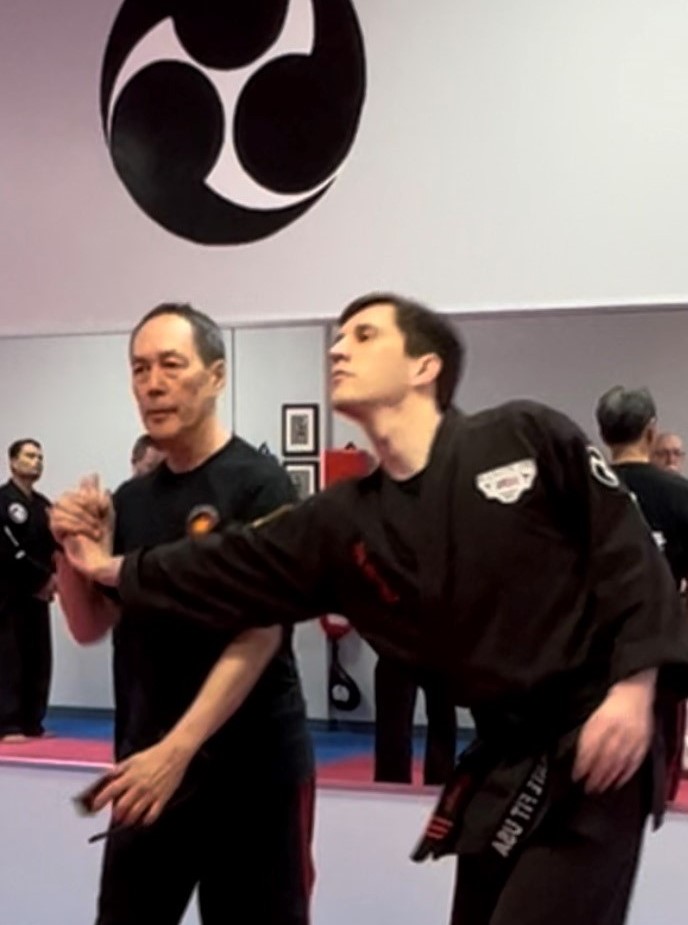PAIN IN THE MARTIAL ARTS – my thoughts
Proper martial arts training brings many benefits to many kinds of people, and different people train for different reasons. While self-defense is not the main goal of all participants, and we need to work safely within our partner’s comfort level, at its core martial arts is a fighting art that help us with non-fighting aspects of our lives. So here are 7 of my thoughts:
1. PAIN MAKES BELIEVERS: This is one of the mottos of the late Prof. Wally Jay, creator of the Small Circle Jujitsu (SCJ) that is also part of what we do. Pain compliance involves controlling an opponent by using their primal reaction to shut down and avoid damage in painful positions. A joint in extreme pain causes the body to be unable to use even joints that are not directly in pain, and we can control the whole body through one (or more) joints.
2. PAIN AND DAMAGE ARE DIFFERENT: Damage causes pain, but pain does not have to cause damage. Prof. Jay learned this once when he had to use his early boxing skills to protect himself and sent the other person to the hospital. It troubled his conscience, and after he got into Jujitsu he appreciated and developed the methods to protect oneself from attackers without necessarily needing to damage them. We are also extra careful with kids, whose joints are still developing, so wait on some techniques until older, to avoid short or long-term damage. Likewise, you should not do stretching or other such work to the point of pain, as that usually correlates to damage.
3. PEOPLE EXPERIENCE PAIN DIFFERENTLY: Different people are more/less sensitive to certain techniques, or to pain in general, and attackers on drugs might not feel anything. In practice we need to slowly build intensity to avoid damaging partners, and in self-defense we would like to have mechanical control with locks even if pain is insufficient, and we should be ready to cause damage if necessary to protect ourselves. In self-defense, utilize everything so as not to rely on any one thing.
4. PAIN TEACHES RESPECT: Most of our SCJ techniques do not require strength, so it might not feel like you are actually doing anything. It is important to actually DO the techniques on a partner so that both people feel what a controlled application does. When you apply a finger lock, it might not feel strong or effective, but when it is properly applied to you the pain should help you appreciate and respect the technique. The pain can be gradually increased, and will stop when you tap, but stopping before that point does not let you know if you are doing it correctly, or how effective it actually can be. When an instructor tells you that “they should do this,” you need to then confirm it is true and that you can do it. This gives you the competence and confidence to be able to actually use the technique. -Pain makes believers!
5. “BUT I DON’T LIKE PAIN”: I get it – few people do! “Pain” normally equates to “damage,” and we don’t want to damage ourselves. But pain that does not cause damage is less scary, and more importantly, can be controlled to be intense or gentle. Growing up in a “hard” karate style, we would punch makiwara to toughen our hands and smash blocks into each other to toughen arms, etc. It was painful, and is different from SCJ pain. It was controlled, intentional damage, and in my opinion, is optional. (Everything is optional, of course!) Damaging pain is usually best avoided, and non-damaging pain needs to be controlled appropriately.
6. GET COMFORTABLE BEING UNCOMFORTABLE: Getting a little out of your comfort zone is the best way to learn, and if you ever do need to defend yourself again someone it is helpful to become a little less uncomfortable with such things. Our SCJ locks and controls can be done gently (or intensely), so don’t be too worried: Work slowly with your partner, and gently continue the technique until the desired reaction begins. Be ready to stop when your partner signals you can/should stop, and they will do the same for you. This will train your body to react properly if you should ever need to, and then you are also in charge of how intensely you do that!
7. WORK WITH YOUR PARTNER: Let them know how slow/fast or gentle/hard you are comfortable going, and also listen to them. If issues or injuries exist, make sure both people know. Then train at the level the least comfortable person is, so that everyone is okay with it. (If your partner wants you to go harder/faster and you are not comfortable, let them know that and do go harder than you can control.) Try to work with different partners, as different people respond differently and are more/less sensitive, as this helps your understanding and training. Just make sure both people understand each other.
Happy training!
Kids Martial Arts Classes - try for free!
Thank you for contacting us. We will follow up with you as soon as we can to answer any questions you might have and to schedule your free trial class! You can also call or text 609-690-9060 for more info, and can pre-register for your trial class at www.karatefitusa.net/signup
Adult Martial Arts - Try a Free Class!
Thank you for contacting us. We will follow up with you as soon as we can to answer any questions you might have and to schedule your free trial class! You can also call or text 609-690-9060 for more info, and can pre-register for your trial class at www.karatefitusa.net/signup


